Video consultations - public and clinician views: consultation summary
Summary of the national public engagement exercise held during June to August 2020, to understand the general public and health professionals’ views on using Near Me video consulting.
Key findings
1. High acceptability for the use of video consulting
- Almost nine of ten (87%) public respondents thought video consulting should be offered for health and care appointments (Figure 1).
- This figure was closely matched by those people who responded by phone or hard copy, with 81% of this group saying video consulting should be offered for health and care appointments.
- For health care professionals, 94% thought video consulting should be offered for health and care appointments, with 4% unsure and only 2% thought video should not be used.
- Public responses were analysed to control for gender, disability, age band, health board and previous use of Near Me. There was little difference in views between females and males (87% vs 88%) or for people with or without a self-reported disability (88% v 82%). Although a drop off in support for video consulting was seen in older age groups, it was a relatively small reduction (Figure 2).
- One surprising result was the high percentage of females responding (80%) for which we have no explanation.
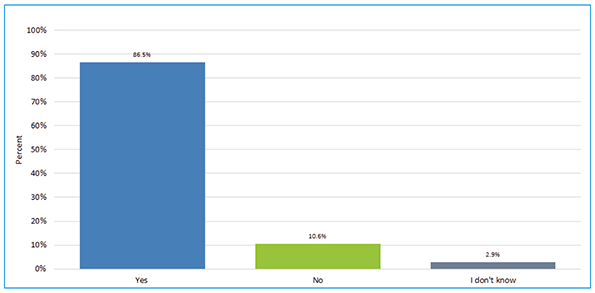
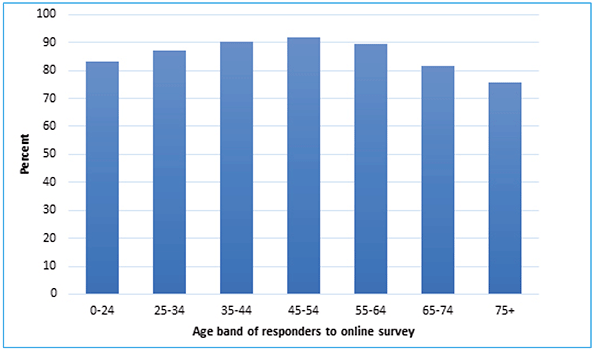
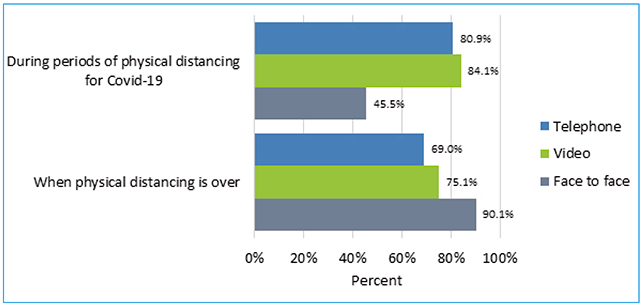
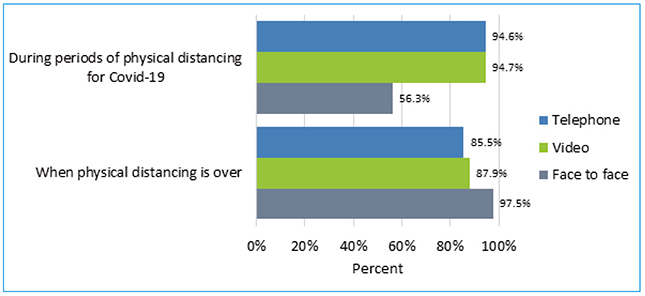
2. Public preference for use of video over phone consulting
- The public stated a slight preference for use of video over phone consulting both during periods of physical distancing for Covid-19 and afterwards. Video was the most preferred option during periods of physical distancing, with face to face the most preferred option once physical distancing is over (Figure 3).
" I have no problem with this format of communication for those who are happy to use it. I just need to know that choice will be available."
- This contrasted with the health care professional views who had a smaller preference for video over phone, and overall scored the acceptability of phone consulting more highly than patients (Figure 4).
3. Near Me has a wide range of potential use
- Health professionals identified a wide range of potential uses for Near Me (Table 2).
- A clear preference was identified for use of video consulting within ongoing management of conditions (eg, asthma, mental health conditions, various out- patient follow up appointments), rather than in undifferentiated diagnosis (eg, first presentation of abdominal pain).
- Health professionals were also asked if there were any consultations when they would not use video: Three out of four who responded (75%) said there were some, with the most frequently cited being when a physical examination is required.
- This feedback backs up the positioning of Near Me as a tool that should be used where appropriate (considering clinical conditions, and patient factors including social circumstances and choice).
4. Benefits of video consulting
Both the public and health professionals identified the lower infection risk of video consulting as the number one benefit (Table 3), which reflects the period in which this consultation took place (during the Covid-19 pandemic). Notably, this benefit was previously only described as a minor benefit for using video consulting (eg, to reduce people coming into GP practices with norovirus).
" This video consultation would be so beneficial for residents in rural areas where public transport is so expensive and not frequent enough. It would transform many lives and encourage more people to access health services."
Health professionals perceived that the biggest benefits to patients were reducing the need to travel or take time off work, whereas the public scored improving access to services more highly. Another difference was in the importance of the environmental benefits which appeared in the public's top five rated benefits but was much lower in health professionals' perceived benefits for patients.
For health professionals' benefits for themselves, enabling patient access to services was key both in terms of wider access and delivering a method of consultation that patients requested.
The Equality Impact Assessment (EQIA) for Near Me identified the following benefits of Near Me:
| Types of consultation | Health professionals agreeing can be provided by video |
|---|---|
| Advice and support | 88% |
| Active management and/or treatment of an ongoing condition | 73% |
| Review of long-term condition management (including medication reviews) | 66% |
| Follow up after a procedure, operation or hands-on care | 43% |
| Acute presentations | 33% |
| Assessment before a procedure, operation or hands-on care | 31% |
| Other | 16% |
| Don't know | 2% |
Table 3 : Public and health professional views on the benefits of Near Me
Top five benefits of Near Me video consulting (in descending order, biggest benefit first)
Public views
1. Lower infection risk
2. Improves access to services
3. More convenient
4. Saves time
5. Better for the environment
Health professionals' views on benefits for their patients
1. Lower infection risk
2. Reduces the need for patients to travel
3. Reduces the need for patients to take time off work
4. Saves patient time
5. Improves access to services
Health professionals' views on benefits for themselves
1. Lower infection risk
2. Enables wider access to my service
3. Helps me deliver a service my patients have requested
4. Better for the environment
5. Frees up resources within my service through reduced travel
- Enables people to attend appointments in a safe manner, reducing the risk of infection, particularly for older people, individuals shielding and pregnant women.
- Improved access to health and care services through removing travel barriers. This is particularly relevant for people with disabilities, elderly/frail people, people suffering chronic pain, people with carer responsibilities, and people living in rural, remote and island communities.
- Reduced time off work or education to attend appointments was especially relevant for carers, young people, and low socio-economic backgrounds.
- Supports carers, family members and translators to be involved in an appointment, particularly for ethnic minorities, those with disabilities and older people.
5. Barriers of using video consulting
The barriers for using Near Me were, overall, scored by the public and health professionals much lower than benefits.
In terms of disadvantages, both the public and health professionals identified poor internet connectivity and resulting poor call quality, and lack of access to a video calling device as the main issues (Table 4). The public rated a lack of private space for a video call more highly than health professionals anticipated, and health professionals over-estimated patients' need for support to connect calls.
For health professionals, in addition to poor quality of calls, the main disadvantages were concerns about missing something on video and a preference to see patients in person.
Table 4: Public and health professional views on the barriers of Near Me
Top three barriers of Near Me video consulting (in descending order, biggest barrier first)
Public views
1. Poor internet connectivity
2. No private space for a video call
3. No or limited access to a device for video calling
Health professionals' views on barriers for their patients
1. Risk of poor quality sound/ image or call dropping
2. Patients not having access to a video calling device
3. Patients needing support to connect a video call
Health professionals' views on barriers for themselves
1. Risk of poor quality sound/image or call dropping
2. Concerns about missing something on video
3. Prefer seeing patients in person
" Going forward there clearly needs a system in place for people who do not have computers; people who are not comfortable having appointments via video. We need a fair system for everybody."
The Equality Impact Assessment (EQIA) for Near Me identified the following barriers:
- Attitudinal barriers resulting in limited use of Near Me for certain groups where clinicians or organisations may make general assumptions about video appointments not being appropriate for certain cohorts.
- Lack of a safe and confidential space to conduct a video appointment, particularly for younger people in a house with others, carers or those with disabilities and situations where domestic violence occurs.
- Lack of inclusive communication of Near Me information and patient resources limits use, especially for people where English is not their first language, have a learning disability or low literacy skills.
- People who are digitally excluded for whatever reason. Particularly for younger and older people, minority ethnic populations including gypsy travellers, homeless people, rural and remote communities, and those from low socio-economic backgrounds.
6. Improving accessibility of Near Me
The following themes were strongly identified to improve accessibility of Near Me video consulting (Figure 5):
- Improve digital access, both in terms of internet connectivity and access to devices.
- Consider introducing or expanding the idea of local hubs (such as those used in the Highlands), clinics or community-based borrowable devices where people can access Near Me if they do not have their own device or the private space for a consultation, or they lack skills to use video.
- Ensure there is choice over how consultations are provided, so that Near Me is used where it is both clinically appropriate and socially appropriate for an individual patient's situation.
- Improve patient information about Near Me, for example, translated leaflets, awareness about how to make test calls, and clearer information about how to involve interpreters or family members for support in video calls.
" The patients love it, and the clinicians avoid change and make every excuse under the sun as to why it won't work."
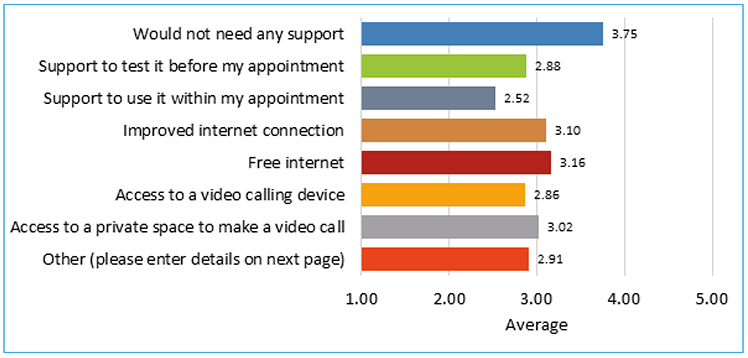
For health professionals, the top five actions to make video consulting easier to use were (in descending order of importance, ie, biggest to smallest impact):
1. Improving digital access to make it easier for all patients to use digital services.
2. Patients requesting video consultations.
3. Ability to provide mixed clinics (some face to face, some video) rather than all video.
4. Improved internet connection at the consulting location of choice.
5. Best practice guidance from professional bodies.
The EQIA examined how to improve accessibility of video consulting services in depth and made the following recommendations:
- Continue to maintain choice and appropriate deployment of consultation type including face to face appointments.
- Consider the need for local hubs/clinics to access Near Me.
- Establish processes to enable interpreters to join Near Me appointments where appropriate. This would include both service-provided interpreters and informal interpreters/support for appointments, such as from family members.
- Establish and communicate processes to enable patients to do a test call.
- Raise awareness about consultation options including appointments by video.
- Continue to build links with Connecting Scotland, Public Health Scotland, and Scottish Council of Voluntary Organisations to understand the scope and impact of digital exclusion on use of Near Me and provide advice to ensure compatibility.
- Develop inclusive communication and guidance materials for using Near Me, including easy read, languages other than English, visual, and bespoke to groups as required (eg, young carers).
- Share best practice inclusive guides/ resources with health boards across Scotland.
" Near Me has provided a vital lifeline to health services and we would welcome its continued use when the current crisis ends."
Contact
Email: nss.tec@nhs.net
There is a problem
Thanks for your feedback